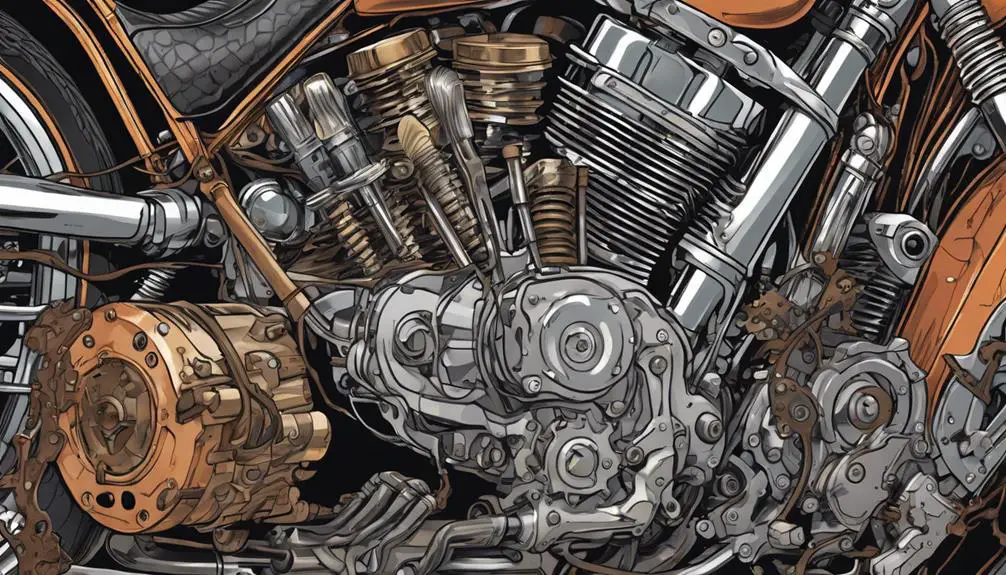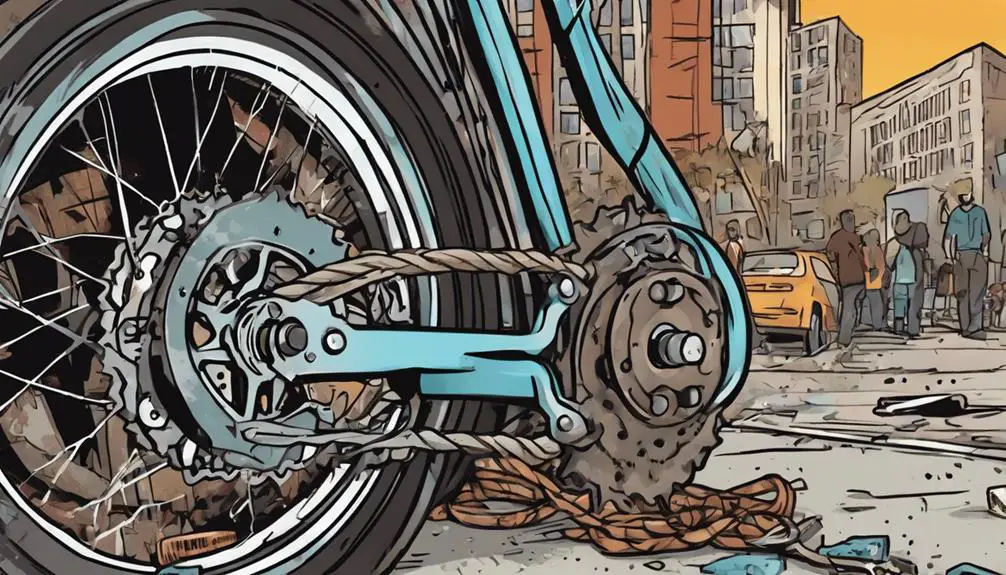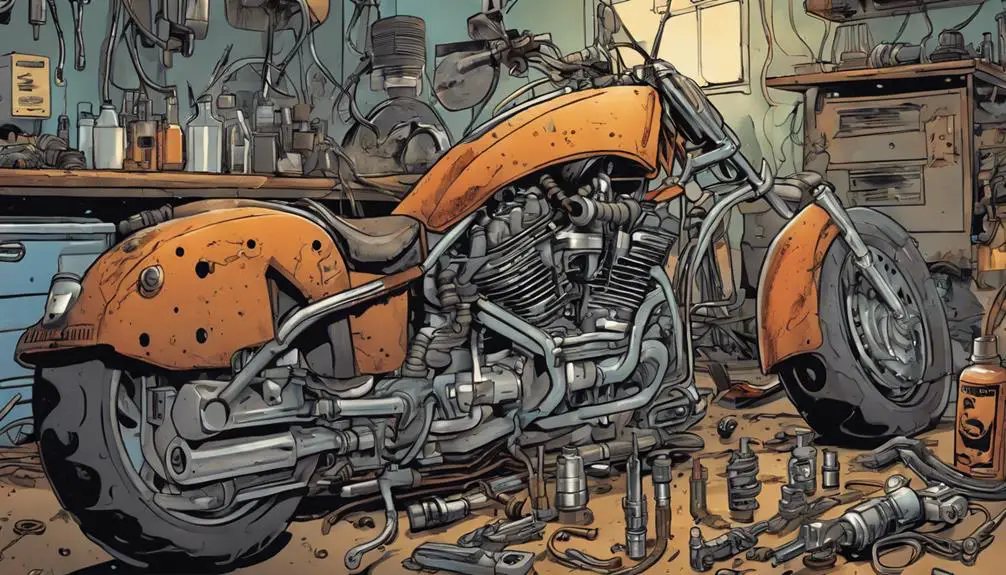When you think about popular Japanese bikes, you might picture reliability and smooth rides, but that's not always the case. You could encounter engine problems that lead to frustrating stalling or electrical failures that drain your battery at the worst times. Then there are brake issues and suspension concerns that can turn a pleasant ride into a bumpy ordeal. Finally, fuel system defects could leave you struggling to accelerate. It's important to understand these common pitfalls before they impact your experience—let's explore these issues further.
Quick Takeaways
- Engine problems often manifest as decreased power, rough idling, or stalling, requiring regular maintenance to prevent severe damage.
- Electrical failures can lead to a dead battery or flickering lights, emphasizing the need for routine checks to avoid starting issues.
- Brake issues such as spongy levers and inconsistent stopping power can arise from worn-out pads or air in the brake line.
- Suspension concerns include bumpy rides and uneven tire wear, indicating a need for regular monitoring and maintenance for optimal performance.
Engine Problems

Engine problems often arise in Japanese bikes, leading to frustrating performance issues that can affect your ride. You might notice a decrease in power, rough idling, or even stalling, which can ruin your sense of freedom on the open road.
It's essential to pay attention to these signs early on; ignoring them can lead to more severe damage and costly repairs down the line.
Common culprits behind engine troubles include fuel system issues, such as clogged filters or dirty injectors. These can starve your engine of the fuel it needs to perform at its best.
Overheating can also become a major concern, often due to low coolant levels or a malfunctioning thermostat. You'll want to keep an eye on your bike's temperature gauge to avoid getting stranded.
Regular maintenance can greatly reduce the risk of engine problems. Make sure you're checking the oil levels and changing it regularly, as dirty oil can lead to considerable wear and tear.
Embrace the joy of riding by giving your bike the care it deserves, and you'll guarantee that your adventures remain unshackled by mechanical issues. Keep your wheels turning and your spirit soaring!
Electrical Failures
Electrical failures can leave you stranded and frustrated, as they often disrupt essential systems like lighting, ignition, and charging. Imagine cruising down an open road when suddenly everything goes dark, robbing you of the freedom you seek. These issues can arise unexpectedly, turning your ride into a nightmare.
Consider what you might face:
- Dead battery: You turn the key, but silence greets you instead of the roar of your engine.
- Flickering lights: You're riding at night, and your headlights dim, casting shadows on your path.
- Failed ignition: You pull over for a break, but your bike refuses to start when you're ready to roll.
To truly enjoy the liberation of riding, you need to stay vigilant about electrical systems. Regular checks can help you spot potential issues before they leave you stranded.
Don't let electrical failures hold you back; embrace the freedom of the ride with a well-maintained bike.
Brake Issues

Brake issues can sneak up on you, turning a smooth ride into a harrowing experience when you least expect it. You rely on your brakes to give you confidence and control, but when they start to falter, it can feel like your freedom is slipping away. Whether it's a spongy brake lever, inconsistent stopping power, or strange noises, these problems demand your immediate attention.
Many popular Japanese bikes come equipped with hydraulic disc brakes, known for their efficiency. However, if you neglect regular maintenance, you might find yourself facing issues like air bubbles in the brake line or worn-out pads. This could lead to longer stopping distances or even brake failure, which can endanger you and others on the road.
Don't ignore warning signs. If you notice your brakes feeling off, it's vital to investigate. Regularly check your brake fluid levels, inspect the pads, and replace them as needed. By keeping your braking system in top shape, you not only guarantee your safety but also maintain the exhilarating freedom that riding brings. After all, nothing should stand between you and the open road.
Suspension Concerns
Suspension concerns can greatly affect your ride quality, making it essential to address any signs of trouble before they escalate. A well-tuned suspension system is vital for comfort and control, so don't ignore those little warning signs.
You might notice:
- Bumpy rides that jar your body, reducing the joy of the open road.
- Uneven tire wear, which can lead to costly replacements and unsafe handling.
- Increased braking distance, as a compromised suspension affects your bike's stability.
If you sense any of these issues, it's time to take action. Regularly check your suspension settings and components, ensuring they're in tip-top shape. Don't wait until your ride feels like a chore; embrace the freedom that comes with a smooth, responsive suspension.
With a little attention, you can enjoy the exhilarating experience of riding without the nagging worries of suspension problems holding you back. So, gear up and keep your ride liberated, because the road is your canvas, and you deserve the best experience possible!
Fuel System Defects

While a smooth ride depends on a well-tuned suspension, your bike's performance also heavily relies on a properly functioning fuel system. Fuel system defects can manifest in various ways, affecting your ride's power and efficiency. You might notice poor acceleration, rough idling, or even stalling—signs that something's off.
One common issue is clogged fuel injectors. When dirt and grime build up, they restrict fuel flow, leaving your bike gasping for power. Keeping your fuel system clean is essential; using high-quality fuel and regular maintenance can help prevent these problems.
Another concern is fuel pump failure. If your bike struggles to start or suddenly loses power while riding, it could be a sign that the fuel pump isn't delivering the necessary pressure. Don't wait until you're stranded on the side of the road; a proactive approach can save you from unwanted detours.
Lastly, watch out for leaks in the fuel lines. Not only can these leaks affect performance, but they also pose safety risks. By addressing fuel system defects promptly, you can guarantee that your ride remains exhilarating and liberating.
Common Questions
How Does Maintenance Affect the Longevity of Japanese Bikes?
Maintenance plays an essential role in the longevity of your Japanese bike.
When you regularly check the oil, clean the chain, and inspect the tires, you're ensuring your ride stays in top shape.
Neglecting these tasks can lead to bigger problems down the road, costing you more time and money.
Are There Specific Models Prone to More Issues Than Others?
You might think all bikes are created equal, but some models have a reputation for more issues than others.
While you revel in the freedom of the open road, certain Japanese bikes can surprise you with unexpected quirks.
It's essential to research specific models before diving in.
If you're not careful, a seemingly perfect ride might lead to frustrating trips to the mechanic, taking away from the joy of your journey.
What Are the Common Signs of Wear in Japanese Bikes?
When you're checking for signs of wear in Japanese bikes, look for frayed cables, leaking fluids, or worn tires.
Listen for unusual noises from the engine or brakes, and watch for rust or corrosion on metal parts.
If the bike feels unsteady or has trouble starting, that's a red flag.
Regular inspections and maintenance help you catch these issues early, ensuring you ride freely and confidently on the open road.
How Can I Improve My Bike's Overall Performance?
To improve your bike's overall performance, start by keeping it well-maintained. Regularly check tire pressure, oil levels, and brakes.
Upgrade your air filter and spark plugs for better efficiency. You can also lighten your bike by removing unnecessary accessories.
Consider tuning the suspension to match your riding style, too. Finally, practice your riding techniques; they can greatly enhance how your bike performs.
Embrace the freedom of the open road!
What Accessories Can Help Prevent Common Issues in Japanese Bikes?
When it comes to keeping your ride in tip-top shape, a few clever accessories can work wonders.
Think about investing in a quality chain lube to guarantee smooth shifts, and a reliable tire pressure gauge to maintain peak handling.
A protective cover can shield your bike from the elements, while a sturdy toolkit lets you tackle minor repairs on the go.
With these essentials, you'll be ready to enjoy the freedom of the open road!
Wrapping Up
In the world of Japanese bikes, keeping your ride in top shape is like tuning a fine instrument—every part needs to play its role.
By staying vigilant about engine problems, electrical failures, brake issues, suspension concerns, and fuel system defects, you can guarantee a smooth and safe journey.
Regular maintenance isn't just a chore; it's the key to releasing your bike's full potential.
So, don't wait—tune up and hit the road with confidence!